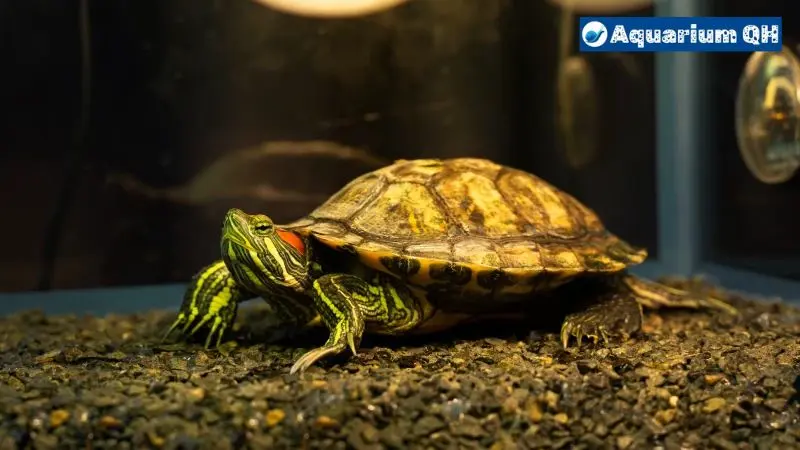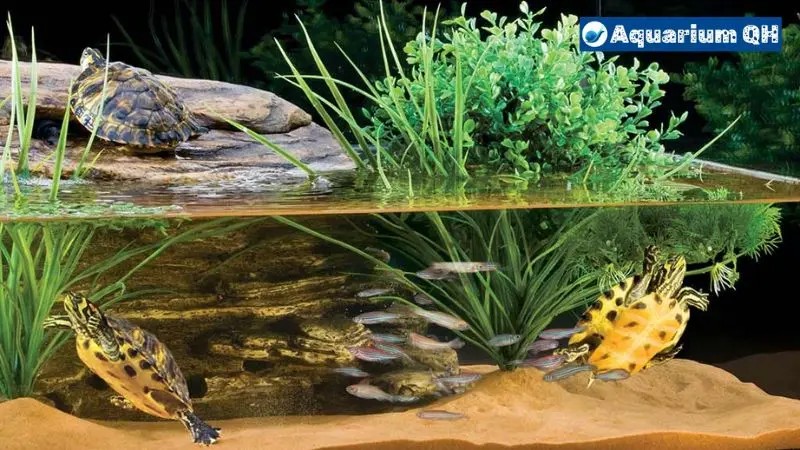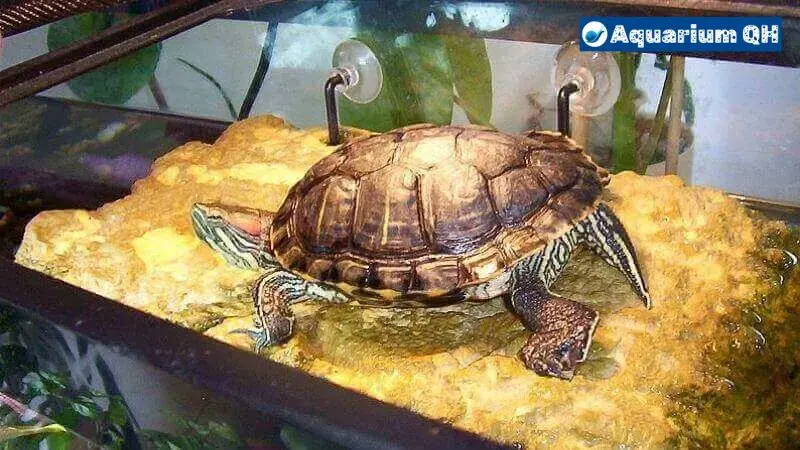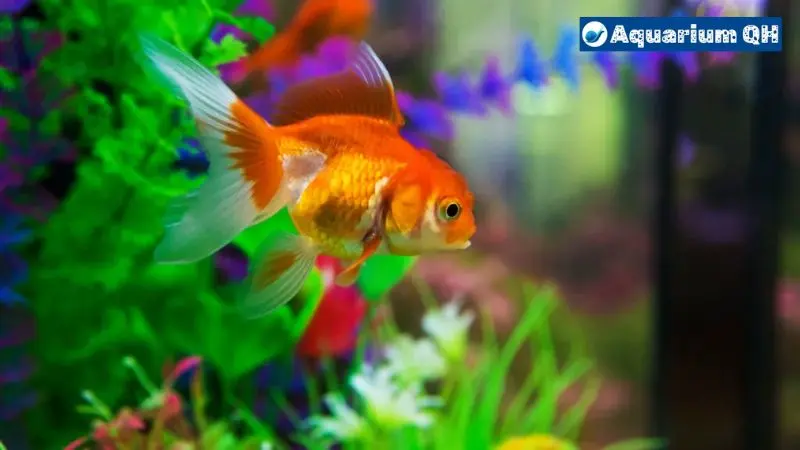The distinct rotten egg smell that sometimes arises from turtle tanks is concerning for pet owners. While the odor is unpleasant, in most cases it does not indicate a severe issue. The smell is caused by hydrogen sulfide gas, which is a product of decomposing waste materials in the tank.
With attentive care and proper tank setup, turtle owners can enjoy their pets without unpleasant odors. This Aquarium QH‘s guide covers the causes, solutions, and preventative measures to eliminate foul hydrogen sulfide smells in turtle aquariums. By understanding the root of the issue and making a few tank adjustments, the problem can be resolved.
Causes of the Smell

There are a few common causes of a rotten egg smell in a turtle tank:
Build up of Waste and Debris
Turtles are messy eaters and produce a lot of waste. Uneaten food, poop, and other debris can accumulate at the bottom of the tank. As this waste breaks down, it releases hydrogen sulfide gas which smells like rotten eggs. A build up of waste is more likely to occur if the tank is overcrowded or isn’t cleaned frequently enough.
Uneaten Food
Leaving uneaten food in the tank allows it to rot and produce foul odors. Overfeeding can contribute to excess uneaten food. Uneaten pellets, vegetables, and other foods should be promptly removed from the tank to avoid smell issues.
Overfeeding
Feeding turtles more than they can eat in one sitting results in food getting left in the tank too long. This uneaten food rots and causes unpleasant odors. It’s best to only feed an amount of food that turtles will fully consume in 5-10 minutes. Overfeeding also contributes to water quality issues.
Hydrogen Sulfide Gas
Hydrogen sulfide gas is one of the most common causes of a rotten egg smell in turtle tanks. This gas is produced when turtle waste, uneaten food, and other organic matter breaks down in the tank water.
The waste and decaying matter create hydrogen sulfide as a byproduct. This gas has a very distinct rotten egg or sulfur-like odor, even at low concentrations. So if there is excess buildup of waste and debris in a turtle habitat, hydrogen sulfide can become quite noticeable.
The smell is more likely to occur if waste accumulates in hard-to-reach corners, decor items, or filter intakes. Overcrowding and overfeeding can also increase hydrogen sulfide production. The more turtles and waste present, the more gas that can be created through the decomposition process.
Hydrogen sulfide itself is mostly just a nuisance due to the unpleasant smell. But high levels can potentially be toxic to turtles and reduce oxygen in the water. So it’s important to find the source and take steps to remove excess waste when this odor is present. Regular tank maintenance and filtration is key to preventing major hydrogen sulfide buildup.
Overcrowding
Overcrowding is one of the most common causes of a foul, rotten egg smell in a turtle tank. Too many turtles in a small enclosed space leads to an accumulation of waste and debris that causes unpleasant odors.
Turtles are messy eaters and produce a lot of waste. Their feces, urates, and uneaten food quickly build up, especially with inadequate tank filtration. A crowded tank simply cannot keep up with removing all this waste.
As waste accumulates, it begins to decompose and release hydrogen sulfide gas which is the source of the rotten egg odor. The more turtles added to a tank, the more waste produced, and the quicker the smell arises. Even a few extra turtles can throw off the delicate balance in a tank.
Overcrowding also increases competition between turtles for resources like basking space and food. The heightened stress can depress the turtles’ immune systems and make them more susceptible to illnesses that contribute to foul water conditions.
The solution is to avoid putting too many turtles in one tank. Carefully research the appropriate number of turtles for a given tank size and filtration capacity. Generally, 10 gallons per inch of shell length is recommended per turtle. Overcrowding leads to rapid water quality deterioration, so it’s critical to provide adequate space for the mess turtles naturally create.
Insufficient Tank Cleaning
Keeping the turtle tank clean is essential for preventing rotten egg smells. If waste and debris are allowed to build up in the tank, they will begin to decompose and release hydrogen sulfide gas. Turtle waste contains high levels of protein and sulfur, which provide ideal conditions for sulfate-reducing bacteria to thrive. These bacteria metabolize the waste and produce hydrogen sulfide as a byproduct.
The most important maintenance task is frequent water changes and gravel vacuuming. Turtle tanks need more frequent cleaning than fish tanks. A general guideline is to change 25-50% of the water weekly, or more often if water quality declines. Use a gravel vacuum to remove solid waste from the tank bottom and clean decorations and filters during water changes. Neglecting these routine cleaning tasks allows waste to accumulate and decay.
In addition, uneaten food should be promptly removed to prevent it from fouling the water. Any debris that collects on the bottom or decorations should also be siphoned out. Overfeeding can quickly lead to waste buildup. Only feed an amount that turtles can completely finish at each meal.
With diligent tank cleaning and maintenance, hydrogen sulfide gas production can be minimized. Waste removal is key to preventing unpleasant rotten egg odors.
Improper Filtration

A turtle tank that smells like rotten eggs could be caused by improper filtration. The filter may not be powerful enough to handle the bio load in the tank. Turtles are messy animals that produce a lot of waste. If the filter cannot keep up with removing solid waste, uneaten food, and break down ammonia and nitrites, hydrogen sulfide gas can build up.
The filter media may also need to be replaced if it is old and covered in gunk. Most filters use mechanical, biological and chemical filtration. Mechanical filtration removes solid particles. Biological filtration relies on beneficial bacteria to break down ammonia and nitrites. Chemical filtration absorbs odors and discoloration. If the mechanical and biological filtration is not working properly, the chemical filtration can get overwhelmed, resulting in a bad smell.
Replacing filter cartridges or media on a regular basis is crucial. The activated carbon in chemical filtration will stop absorbing odors efficiently after a certain period of time. The bio-media that houses nitrifying bacteria can also get clogged up over time, reducing the biological filtration capacity. Using an underpowered or outdated filter that cannot properly remove waste and gas byproducts will cause the tank water to smell bad. Upgrading to a more powerful filter or replacing filter media is necessary to restore proper filtration and eliminate foul odors.
Solutions
There are several solutions to getting rid of the rotten egg smell in a turtle tank. The most important is frequent water changes. Turtles produce a lot of waste, so their water needs to be changed often to remove ammonia and other compounds that cause odors. Aim to change at least 25% of the water 1-2 times per week.
Using a powerful filter designed for a tank much larger than yours is also essential. The increased filtration will help process waste and prevent buildup of smelly compounds. Make sure to clean the filter media during water changes as directed by the manufacturer.
It’s also important to remove any uneaten food from the tank shortly after feeding. Uneaten food will rot and produce odors. Don’t overfeed your turtles as excess food leads to water quality issues. Only give them what they can finish within 5-10 minutes, 1-2 times per day.
Regular tank cleanings are also key. Use a siphon to remove solid waste from the gravel during water changes. Scrub down tank walls with an algae scraper and rinse decorations in old tank water. A thorough gravel vacuuming during water changes should be done weekly.
Following these preventative measures will keep your turtle tank smelling fresh and clean. The most important are frequent water changes, proper filtration, and removing uneaten food. With good tank maintenance, you can avoid foul rotten egg odors.
Preventative Measures

Keeping a turtle tank from developing unpleasant odors requires diligent maintenance and preventative care. Here are some key steps turtle owners can take:
- Maintain Proper Stocking Levels: Overcrowding a tank leads to excess waste and ammonia buildup. Follow general rules for tank sizes and only house the recommended number of turtles for your setup. Larger tanks allow for more turtles.
- Provide Adequate Filtration: A high-quality filtration system is essential for any turtle habitat. The filter should be rated for at least double the size of the tank and should completely turnover all the water at least 4-5 times per hour. This keeps waste from accumulating.
- Remove Waste Frequently: Even with good filtration, waste and uneaten food will accumulate. Siphon the tank bottom and do partial water changes as needed to remove solid waste before it decays. Aim for 25% weekly water changes.
- Test Water Parameters: Using test kits to monitor ammonia, nitrites, nitrates, and pH can alert you to rising levels before dangerous conditions occur. Take corrective action if levels exceed safe ranges.
Taking preventative steps allows turtle owners to stay ahead of waste issues and avoid unpleasant hydrogen sulfide odors in their turtle habitats. Maintaining ideal water quality keeps turtles healthy too. Consistent tank maintenance is essential for odor control and turtle wellbeing.
When to Seek Help
If the rotten egg smell in your turtle tank persists even after trying the preventative measures and solutions outlined above, it’s time to seek professional help. The smell could be indicative of a larger underlying issue.
Here are some signs it’s time to contact an exotic veterinarian or reptile specialist:
- The smell persists after thoroughly cleaning the tank, changing the water, replacing the filter media, and eliminating possible causes like uneaten food. This likely points to a systemic issue.
- The turtles show signs of respiratory distress like open-mouth breathing, lethargy, loss of appetite, or wheezing. The smell could be due to an infection.
- There are white spots or unusual growths on the turtle’s shell or skin. This may indicate shell rot or a fungal infection.
- The water parameters are normal but the smell won’t go away. There could be an internal bacterial infection.
- You notice any other signs of illness in your turtles like swollen eyes, runny nose, or soft shell.
Don’t hesitate to reach out for professional advice if the smell and any other symptoms don’t resolve on their own. A vet can run diagnostics tests, prescribe antibiotics, and suggest appropriate treatment plans. Leaving underlying health issues unchecked can be detrimental to your turtle’s wellbeing. It’s better to seek help early on before the problems escalate.
Conclusion
If the smell persists despite your best efforts, seek advice from an aquatic turtle specialist. A persistent rotten egg odor likely indicates an underlying issue that needs to be addressed. With some adjustments to your tank maintenance routine and equipment, you can eliminate that unpleasant sulfur stench.




